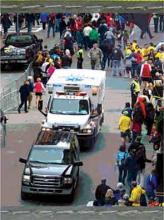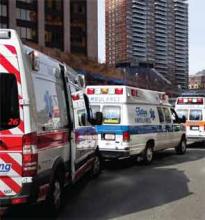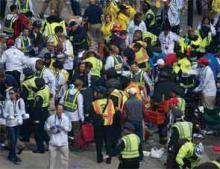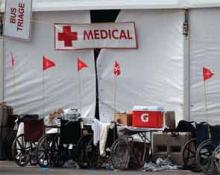User login

—James Hudspeth, MD, Boston Medical Center

—Dan Hale, MD, Floating Hospital for Children at Tufts Medical Center, Boston
Dan Hale, MD, a pediatric hospitalist at the Floating Hospital for Children at Tufts Medical Center in Boston, was doing discharge paperwork when he started getting text messages he couldn’t quite interpret.
“Are you OK?” “Do you need anything?” friends were asking him. Then he heard a page for all anesthesiologists to report to the OR. Immediately, he knew something terrible must have happened. He soon learned about the bombings at the Boston Marathon. He rushed to the pediatric ED to see how he could help.
James Hudspeth, MD, a hospitalist at Boston Medical Center, was meeting with the program director for internal medicine when he read a text message that bombs had just gone off near the finish line. They went online for local news coverage; soon thereafter, a cap on admissions was lifted. Dr. Hudspeth started expediting discharges to make room for what might be coming the hospital’s way.
Sushrut Jangi, MD, a hospitalist at Beth Israel Deaconess Medical Center, was in a medical tent gathering information for an article on treating the health problems of marathoners that he was writing for The Boston Globe when he heard the blasts. Doctors and medical staff there worried about the possibility of a bomb in the tent, he said, but they were instructed to stay with their patients. Dr. Jangi had expected to work as a journalist for the day, but his doctoring skills were needed.
Hospitalists who were working in downtown Boston on April 15, when two bombs exploded 17 seconds apart, all experienced the tragedy in their own ways. But their accounts also resonate within some of the same themes.
They found themselves unsure of their roles, as most of the work inevitably fell to surgeons and trauma specialists. They described the importance of good leadership in times of crisis. And they say that hospitalists should be incorporated to a greater extent into disaster plans.
Dr. Jangi said that before the bombs went off, the medical tent was almost filled with runners who were “quite ill”—hypothermic and shaking, high sodium levels, disoriented. When the blasts occurred, the main instruction was, “Don’t leave your patients behind.” Those who were well enough were released from the tent, and the bomb-blast victims were essentially “whisked through.”
“We just kind of cleared the way and got them into ambulances as soon as possible. We just didn’t have the capacity to take care of such severe injury,” he said. “Why should we? We weren’t expecting a war zone.”
In the tent, Dr. Jangi wrote in an essay for the New England Journal of Medicine, “Many of us barely laid our hands on anyone. We had no trauma surgeons or supplies of blood products; tourniquets had already been applied; CPR had already been performed. Though some patients required bandages, sutures, and dressings, many of us watched these passing victims in a kind of idle horror, with no idea how to help.”
Dr. Hale was not involved in the treatment of bombing victims as the attending of record, but he said that he had a “bird’s-eye view” of the response in the pediatric ED. One child had shrapnel injuries and a ruptured tympanic membrane and was worked on by the team “professionally and efficiently,” Dr. Hale said.
When reports of a possible third bomb blast, at a library, came in, he saw the physician leaders go from team to team, making sure they were prepared.
“There were clear leaders communicating what to do,” said Dr. Hale, a firefighter in his hometown of Kittery in southern Maine. “As patients came in, it was extremely orderly. I saw very few clinical staff who were rattled.”
For his own part, in addition to his medical training, his training as a firefighter helped keep him calm, he said.
At Boston Medical Center, about a mile and a half from the blasts, the admissions that had been worked up over the course of the afternoon were essentially taken all at once so that there was room in the ED, said Dr. Hudspeth, who also does medical work in Haiti and was in New York on 9/11, though not as a doctor.
Focusing, he said, was “definitely a challenge.” Even though he had faith in hospital security, there was still “some notion of ‘You never know exactly what’s going to happen.’”
“You focus on the patient that’s in front of you. You focus on trying to solve the issues that are at hand. You deal with the logistical questions that come up between patients,” he said. “By and large, just put your nose to the grindstone.”
The doctors said that hospitalists had an unclear role in the response effort and hope to have their roles clarified so that they can better put to use their expertise in internal medicine. If hospitalists are monitoring general medical issues, that will help take some of the pressure off the trauma team.
“We know the [general] medicine stuff very well—that is our bread and butter,” said Dr. Hudspeth, who added that steps are being taken as part of Boston Medical Center’s post-response analysis to determine hospitalists’ role in future disaster responses.
They also said they felt fortunate that the bombings had occurred where they did, with so many hospitals close to the scene. It kept the system from becoming overwhelmed. Even so, “at some point, a disaster is so large that it would overwhelm any system, no matter how many resources were available,” Dr. Hale added.
Dr. Jangi said that he thinks his residency training helped him when he found himself having to provide care in a high-pressure situation in the medical tent.
“During residency, there are a lot of situations where you’re responsible for making a decision on your feet,” he said. “That’s a skill that you’re not really exposed to until you do it and that type of fast decision-making. I felt myself drawing on that. Not that I resuscitated anyone in the tent, but I felt more comfortable with uncertainty, with doing your duty in a situation of uncertainty. And I don’t know—maybe if I hadn’t gone through that, I would have just run out of there.”
He said the experience has helped make him more committed as a doctor.
“It makes it easier to remember what my duty is more, and it just gives me more empathy for suffering in general—I feel that very strongly,” he said. “It’s possible that this experience could have numbed me, but it didn’t. It’s made me more acute to the idea of people suffering.”
Tom Collins is a freelance writer in South Florida.
Reference

—James Hudspeth, MD, Boston Medical Center

—Dan Hale, MD, Floating Hospital for Children at Tufts Medical Center, Boston
Dan Hale, MD, a pediatric hospitalist at the Floating Hospital for Children at Tufts Medical Center in Boston, was doing discharge paperwork when he started getting text messages he couldn’t quite interpret.
“Are you OK?” “Do you need anything?” friends were asking him. Then he heard a page for all anesthesiologists to report to the OR. Immediately, he knew something terrible must have happened. He soon learned about the bombings at the Boston Marathon. He rushed to the pediatric ED to see how he could help.
James Hudspeth, MD, a hospitalist at Boston Medical Center, was meeting with the program director for internal medicine when he read a text message that bombs had just gone off near the finish line. They went online for local news coverage; soon thereafter, a cap on admissions was lifted. Dr. Hudspeth started expediting discharges to make room for what might be coming the hospital’s way.
Sushrut Jangi, MD, a hospitalist at Beth Israel Deaconess Medical Center, was in a medical tent gathering information for an article on treating the health problems of marathoners that he was writing for The Boston Globe when he heard the blasts. Doctors and medical staff there worried about the possibility of a bomb in the tent, he said, but they were instructed to stay with their patients. Dr. Jangi had expected to work as a journalist for the day, but his doctoring skills were needed.
Hospitalists who were working in downtown Boston on April 15, when two bombs exploded 17 seconds apart, all experienced the tragedy in their own ways. But their accounts also resonate within some of the same themes.
They found themselves unsure of their roles, as most of the work inevitably fell to surgeons and trauma specialists. They described the importance of good leadership in times of crisis. And they say that hospitalists should be incorporated to a greater extent into disaster plans.
Dr. Jangi said that before the bombs went off, the medical tent was almost filled with runners who were “quite ill”—hypothermic and shaking, high sodium levels, disoriented. When the blasts occurred, the main instruction was, “Don’t leave your patients behind.” Those who were well enough were released from the tent, and the bomb-blast victims were essentially “whisked through.”
“We just kind of cleared the way and got them into ambulances as soon as possible. We just didn’t have the capacity to take care of such severe injury,” he said. “Why should we? We weren’t expecting a war zone.”
In the tent, Dr. Jangi wrote in an essay for the New England Journal of Medicine, “Many of us barely laid our hands on anyone. We had no trauma surgeons or supplies of blood products; tourniquets had already been applied; CPR had already been performed. Though some patients required bandages, sutures, and dressings, many of us watched these passing victims in a kind of idle horror, with no idea how to help.”
Dr. Hale was not involved in the treatment of bombing victims as the attending of record, but he said that he had a “bird’s-eye view” of the response in the pediatric ED. One child had shrapnel injuries and a ruptured tympanic membrane and was worked on by the team “professionally and efficiently,” Dr. Hale said.
When reports of a possible third bomb blast, at a library, came in, he saw the physician leaders go from team to team, making sure they were prepared.
“There were clear leaders communicating what to do,” said Dr. Hale, a firefighter in his hometown of Kittery in southern Maine. “As patients came in, it was extremely orderly. I saw very few clinical staff who were rattled.”
For his own part, in addition to his medical training, his training as a firefighter helped keep him calm, he said.
At Boston Medical Center, about a mile and a half from the blasts, the admissions that had been worked up over the course of the afternoon were essentially taken all at once so that there was room in the ED, said Dr. Hudspeth, who also does medical work in Haiti and was in New York on 9/11, though not as a doctor.
Focusing, he said, was “definitely a challenge.” Even though he had faith in hospital security, there was still “some notion of ‘You never know exactly what’s going to happen.’”
“You focus on the patient that’s in front of you. You focus on trying to solve the issues that are at hand. You deal with the logistical questions that come up between patients,” he said. “By and large, just put your nose to the grindstone.”
The doctors said that hospitalists had an unclear role in the response effort and hope to have their roles clarified so that they can better put to use their expertise in internal medicine. If hospitalists are monitoring general medical issues, that will help take some of the pressure off the trauma team.
“We know the [general] medicine stuff very well—that is our bread and butter,” said Dr. Hudspeth, who added that steps are being taken as part of Boston Medical Center’s post-response analysis to determine hospitalists’ role in future disaster responses.
They also said they felt fortunate that the bombings had occurred where they did, with so many hospitals close to the scene. It kept the system from becoming overwhelmed. Even so, “at some point, a disaster is so large that it would overwhelm any system, no matter how many resources were available,” Dr. Hale added.
Dr. Jangi said that he thinks his residency training helped him when he found himself having to provide care in a high-pressure situation in the medical tent.
“During residency, there are a lot of situations where you’re responsible for making a decision on your feet,” he said. “That’s a skill that you’re not really exposed to until you do it and that type of fast decision-making. I felt myself drawing on that. Not that I resuscitated anyone in the tent, but I felt more comfortable with uncertainty, with doing your duty in a situation of uncertainty. And I don’t know—maybe if I hadn’t gone through that, I would have just run out of there.”
He said the experience has helped make him more committed as a doctor.
“It makes it easier to remember what my duty is more, and it just gives me more empathy for suffering in general—I feel that very strongly,” he said. “It’s possible that this experience could have numbed me, but it didn’t. It’s made me more acute to the idea of people suffering.”
Tom Collins is a freelance writer in South Florida.
Reference

—James Hudspeth, MD, Boston Medical Center

—Dan Hale, MD, Floating Hospital for Children at Tufts Medical Center, Boston
Dan Hale, MD, a pediatric hospitalist at the Floating Hospital for Children at Tufts Medical Center in Boston, was doing discharge paperwork when he started getting text messages he couldn’t quite interpret.
“Are you OK?” “Do you need anything?” friends were asking him. Then he heard a page for all anesthesiologists to report to the OR. Immediately, he knew something terrible must have happened. He soon learned about the bombings at the Boston Marathon. He rushed to the pediatric ED to see how he could help.
James Hudspeth, MD, a hospitalist at Boston Medical Center, was meeting with the program director for internal medicine when he read a text message that bombs had just gone off near the finish line. They went online for local news coverage; soon thereafter, a cap on admissions was lifted. Dr. Hudspeth started expediting discharges to make room for what might be coming the hospital’s way.
Sushrut Jangi, MD, a hospitalist at Beth Israel Deaconess Medical Center, was in a medical tent gathering information for an article on treating the health problems of marathoners that he was writing for The Boston Globe when he heard the blasts. Doctors and medical staff there worried about the possibility of a bomb in the tent, he said, but they were instructed to stay with their patients. Dr. Jangi had expected to work as a journalist for the day, but his doctoring skills were needed.
Hospitalists who were working in downtown Boston on April 15, when two bombs exploded 17 seconds apart, all experienced the tragedy in their own ways. But their accounts also resonate within some of the same themes.
They found themselves unsure of their roles, as most of the work inevitably fell to surgeons and trauma specialists. They described the importance of good leadership in times of crisis. And they say that hospitalists should be incorporated to a greater extent into disaster plans.
Dr. Jangi said that before the bombs went off, the medical tent was almost filled with runners who were “quite ill”—hypothermic and shaking, high sodium levels, disoriented. When the blasts occurred, the main instruction was, “Don’t leave your patients behind.” Those who were well enough were released from the tent, and the bomb-blast victims were essentially “whisked through.”
“We just kind of cleared the way and got them into ambulances as soon as possible. We just didn’t have the capacity to take care of such severe injury,” he said. “Why should we? We weren’t expecting a war zone.”
In the tent, Dr. Jangi wrote in an essay for the New England Journal of Medicine, “Many of us barely laid our hands on anyone. We had no trauma surgeons or supplies of blood products; tourniquets had already been applied; CPR had already been performed. Though some patients required bandages, sutures, and dressings, many of us watched these passing victims in a kind of idle horror, with no idea how to help.”
Dr. Hale was not involved in the treatment of bombing victims as the attending of record, but he said that he had a “bird’s-eye view” of the response in the pediatric ED. One child had shrapnel injuries and a ruptured tympanic membrane and was worked on by the team “professionally and efficiently,” Dr. Hale said.
When reports of a possible third bomb blast, at a library, came in, he saw the physician leaders go from team to team, making sure they were prepared.
“There were clear leaders communicating what to do,” said Dr. Hale, a firefighter in his hometown of Kittery in southern Maine. “As patients came in, it was extremely orderly. I saw very few clinical staff who were rattled.”
For his own part, in addition to his medical training, his training as a firefighter helped keep him calm, he said.
At Boston Medical Center, about a mile and a half from the blasts, the admissions that had been worked up over the course of the afternoon were essentially taken all at once so that there was room in the ED, said Dr. Hudspeth, who also does medical work in Haiti and was in New York on 9/11, though not as a doctor.
Focusing, he said, was “definitely a challenge.” Even though he had faith in hospital security, there was still “some notion of ‘You never know exactly what’s going to happen.’”
“You focus on the patient that’s in front of you. You focus on trying to solve the issues that are at hand. You deal with the logistical questions that come up between patients,” he said. “By and large, just put your nose to the grindstone.”
The doctors said that hospitalists had an unclear role in the response effort and hope to have their roles clarified so that they can better put to use their expertise in internal medicine. If hospitalists are monitoring general medical issues, that will help take some of the pressure off the trauma team.
“We know the [general] medicine stuff very well—that is our bread and butter,” said Dr. Hudspeth, who added that steps are being taken as part of Boston Medical Center’s post-response analysis to determine hospitalists’ role in future disaster responses.
They also said they felt fortunate that the bombings had occurred where they did, with so many hospitals close to the scene. It kept the system from becoming overwhelmed. Even so, “at some point, a disaster is so large that it would overwhelm any system, no matter how many resources were available,” Dr. Hale added.
Dr. Jangi said that he thinks his residency training helped him when he found himself having to provide care in a high-pressure situation in the medical tent.
“During residency, there are a lot of situations where you’re responsible for making a decision on your feet,” he said. “That’s a skill that you’re not really exposed to until you do it and that type of fast decision-making. I felt myself drawing on that. Not that I resuscitated anyone in the tent, but I felt more comfortable with uncertainty, with doing your duty in a situation of uncertainty. And I don’t know—maybe if I hadn’t gone through that, I would have just run out of there.”
He said the experience has helped make him more committed as a doctor.
“It makes it easier to remember what my duty is more, and it just gives me more empathy for suffering in general—I feel that very strongly,” he said. “It’s possible that this experience could have numbed me, but it didn’t. It’s made me more acute to the idea of people suffering.”
Tom Collins is a freelance writer in South Florida.



